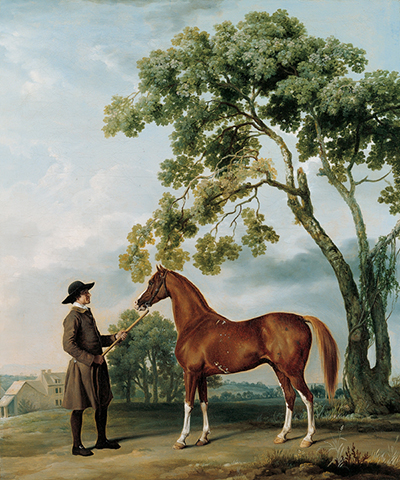In this painting, the characteristically uncompromising spirit of George Stubbs plus his quest for balanced tones and calibrated composition are certainly evident in this Lord Grosvenor's Arabian stallion portrait.
It was painted for Richard Grosvenor, seventh baronet and first Earl Grosvenor Eaton Hall, London and Cheshire by descent to Robert Grosvenor, his son, second Earl Grosvenor (later first Marquess of Westminster) Eaton Hall, Grosvenor House and Cheshire, London.
There's some question concerning the original format and size of this painting. Peter Mazell's engraving Lord Grosvenor’s Arabian, executed in 1771, shows the same scene which is expanded to incorporate a landscape on its left. When the artwork was examined taking into consideration this question, physical evidence was not conclusive. The tacking edges were trimmed from all 4 sides, hence determining the original dimensions wasn't possible. Cusping in the painting could be seen in the x-radiograph only on the bottom and top but was not visible on the left side of the right edges. That could imply that the canvas was cut on its sides, or maybe it could be as a result of the canvas fabric's structure and its reaction to stretching.
The idea of the stretcher seen in the paint surface and the craquelure pattern implies the picture has been preserved in the current form for a very long period. While the engraving horizontal format is normally found in other works done by the artist, a small contemporary painted print by J. N. Sartorius, which is in J. R. S. Edmonds collection, re-emphasises the present composition.
The artist uses a low horizon, with soft foliage and rolling hills, to effectively showcase the chestnut Arabian warm tones. An early reproductive copy of the picture reveals that the landscape was initially wider to the left side; the canvas appears that it was cut down on the side in the late 18th or early 19th century.
The cheerful mien of the young horse, nostrils wide and ears pricked, has been set skillfully in contrast with the groom's reassuring demeanour. Stubbs meticulously depicts its genetic Sabino markings, which includes the white stockings, broad blaze as well as the white spots on the sides and belly. While the artist painted a lifelike portrait of the young horse, he has also emphasised the beauty plus harmony of the figures' silhouettes curving lines.




